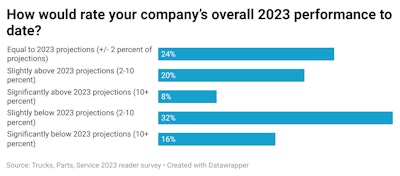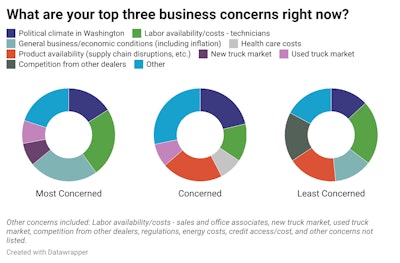
Eric Starks, chairman of FTR Transportation Intelligence, says if there’s no freight to move, there will be no sales of trucks or trailers.
“We always say we have to understand the freight market first, and that will tell us what the equipment market is going to do,” Starks says. “The freight market [in 2023] has been just OK. It’s not awful, it’s not great. When you’re in that kind of a market, you’re only looking at replacing the equipment you already have.”
That’s equipment largely bought during the boom years of 2021 and 2022, when money was cheap and freight plentiful.
[Download our state of the industry survey results!]
Rusty Rush, president, chairman and CEO of Rush Enterprises, was surprised by the year his company had in 2023, even with the dip in the freight market.
“I’m a little baffled by what happened this past year,” Rush said in December. “I’m surprised we had such a strong year in sales.”

Most dealer respondents to a Trucks, Parts, Service reader survey in late 2023 weren’t as surprised by the strength of their year. Around a third (32%) of dealers surveyed said their performance in 2023 was slightly below projections (2-10%) and 16% said it was significantly below projections (more than 10% off). A quarter, or 24%, said they were right on target and 28% were in the boat with Rush with slightly above or significantly above projections.
Experts chalk any strength in truck and trailer sales up to the last of the pandemic cash and filling the tail end of a backlog created by COVID-19 supply chain issues. But the well is running dry on both of those fronts and interest rates are higher than they’ve been in ages.
This year, dealers are going to have to work for their sales.
Get sales teams tuned up
Rush says now that the good times are over, he hopes his people remember how to sell.
Any time there’s a boom, there’s eventually a day of reckoning, he says, and it will come in 2024. Rush Enterprises is forecasting a 20% pull back in the coming year as people get concerned about pricing and smaller carriers just aren’t able to hang on.

Around 80% of TPS survey respondents said they sold new trucks fleets with 100-500 trucks, and 27% said they served fleets operating more than 500 trucks. That’s in addition to smaller fleets and owner-operators. Used trucks went primarily to owner-operators and small fleets (94% of respondents reported they sold used trucks to these customers), with the next biggest group of likely buyers being fleets with 10-25 trucks (69%).
That’s where Starks sees trouble.
“We see the small- and medium-sized fleets really struggling,” he says. “It’s going to be the large fleets staying in. Dealers need to look at large fleets, because it’s going to be very difficult for smaller operators to be overly active.”
Steve Tam, vice president at ACT Research, says his company’s outlook is even more bearish in terms of new sales. Tam and company are calling for a 20-25% year-over-year decline in U.S. Class 8 production and sales.
“Our outlook is based on the expectations of a soft freight environment and excess capacity,” Tam says. “We have already seen the effects of this situation on spot rates, which are just now beginning to recover. However, contract rates typically lag spot rates, so it will most likely be the middle of 2024 before the contract rate environment begins to improve. Lower rates put downward pressure on profits and capital investment.”
Rush says he expects vocational markets to remain strong and so does Tam and so do TPS respondents.
“[The] vocational market is solid with all the road, bridge and infrastructure work going on,” one says. “With the increase [in] costs of new trucks with the new emissions to meet 2027 regulations, we believe there will be a pre-buy starting next year.”
Jerry Kocan, president and general manager of Four Star Freightliner, says in his southeast U.S. market, truck load and less-than-truckload carriers are starting to see weakness, but vocational and medium duty are holding their own.
Rush also expects a pre-buy to start at the end of 2024, but he and other dealers are focusing on parts and service to pay the bills. With fleets holding on to equipment, those trucks will need to be maintained and repaired. Starks says service will be the dealer’s “saving grace.”
“We don’t expect freight demand to collapse, so [fleets] are holding equipment and maintaining it,” Starks says. The frustrating part for dealers, he says, is many large fleets go directly to the OEM for any new truck orders, so service and parts are going to be where the money will be made.

About a third of TPS respondents (34%) expect a drop in sales in 2024, with the majority seeing flat new truck sales or even a little bump as the last of the pandemic backlog works its way through the system.
“In this still-constrained market, many customers are still not able to get all of the trucks they want when they want them,” ACT’s Tam says. “While much of the pent-up demand has been satisfied, there are still some deliveries that have not been made. And delayed replacement has the effect of aging the fleet, a dynamic that will eventually have to be rectified.”
Kocan says Four Star has some of those late deliveries on its books.
“As a group, we did not meet our obligations relative to delivery times, so we are behind on some of our customer base,” he says.
Used truck market past the bottom

Expectations for used truck sales are similar to new. A little more than a third of respondents (38%) expect slightly lower or significantly lower sales of used trucks in 2024. Another third (31%) see flat sales and 31% see higher sales than 2023.
Tam says the used market may outperform new this year.
“Even though it will be impacted by the same dynamics, we expect the used truck market to fare a little better than the new truck market in 2024,” he says. “We expect to see volumes increase around 5% year-over-year. Pricing should stabilize on a month-over-month basis, but will still be lower when looking from year to year. Positively, prices should bottom above the trough of the previous cycle.”
“I think in 2024 we’ll see a bit of softening in new trucks, and that will reducing overall capacity, putting upward pressure on spot rates, and improving economic conditions for owner operators” adds Brock Gavin, president at Arrow Truck Sales. “We’ll be keeping our eye on the demand side of things to manage that.”
Starks also notes the glut of used truck buyers who overpaid for equipment during the post-pandemic boom who are still trying to get their finances right. The fact that some of them have, either paying off the note completely or managing to remain right-side-up has kept used trucks from a total collapse.
Gavin says keeping those customers in their equipment should be remain a priority.
“Everyone is best off if we can keep a customer in their truck,” he says. “We always work with customers to try and keep them current; sometimes we’ll even work with customers for repair loans and modifications.”
Gavin says Arrow tried to do that last year too, but says some customers still “couldn’t see their way out.
“When you see your revenues drop by a dollar [per mile], it’s hard to recover from that.”

The good news is most used truck buyers still want late-model equipment. Respondents to Trucks, Parts, Service’s readership survey said the majority of the trucks their customers run (60%) are less than six years old.
And while year-over-year numbers for both new and used equipment are discouraging, Starks says they don’t paint the whole picture. Instead, compare pricing to pre-COVID numbers and you’ll see prices are stabilizing in the mid-range.
“It’s perspective,” Starks says.
Trailer market more volatile

About a third of respondents (33%) see lower trailer sales in their crystal balls, while about half (44%) see flat growth.
Tam and ACT are forecasting a similar drop to new truck sales.
“Dry vans and flatbeds will see the biggest impact, forecast to fall about 20% year-over-year in 2023,” he says. “Refrigerated van trailers are somewhat insulated from the volatility in the dry freight market, since we all have to eat, even in a weaker economy. Given that, production is expected to fall around 12-13% year-over-year. Most of the other specialty trailer types should see smaller declines, partially offsetting the van and flatbed slowdown, with the total trailer market decreasing 15-20% year-over-year in 2024.”
Smoother sailing for supply chains
Tam calls supply chain issues a perennial challenge these days.
“We would like to believe the industry will be able to finally put [COVID-induced supply chain issues] to bed in 2024,” he says. “However, the reality is there are always challenges in this regard, so the likelihood is there is some issue lurking out there that will conspire to disrupt the manufacturers’ best-laid plans in 2024.”

TPS survey results showed dealers are still concerned about supply chain issues. About half of respondents (46%) noted product availability, including supply chain disruptions, as a top business concern. Around half of surveyed dealers (48%) expanded product lines in 2023.
Starks says supply chains look good, at least for the first quarter of 2024. And, as long as inventories stay right-sized, supply chains should continue to be good. But there may be a problem toward mid-year if inventories get depleted.
Steve Goodman, general manager at Inland Kenworth in Arizona, says he expects supply chain issues to multiply as trucks and drivetrains become more complicated. Supplier constraints was one of his biggest issues in 2023, and he is looking for it to continue into 2024.
Four Star Freightliner’s Kocan says supply chain was one of his biggest problems in 2023 and he’s still seeing issues into 2024. The new year brought frame rail supply issues that Kocan says will force production on seasonal inventory to be delayed, increasing dealer costs.
“We really should review our supply chain strategy as an industry as we are far too reliant on supply being shipped on containers instead of delivering them from U.S. factories,” Kocan says.
This is Part 1 of Trucks, Parts, Service's three-part industry status report entering 2024. Part 2 focuses on the aftermarket sector and Part 3 addresses the supplier community.









